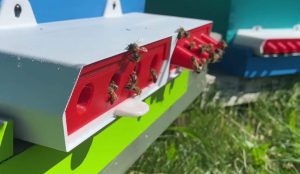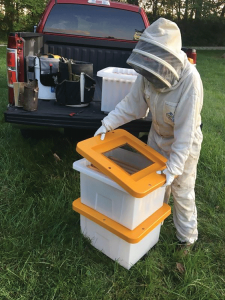 The Hive Butler™ “Working, even when you’re not!”
The Hive Butler™ “Working, even when you’re not!”
Tired of precious honey frames in dirty supers, old coolers or cheap office totes? We sure were. Every time the frames stuck together or gashed each other open, we swore we’d make something better! Something designed just for holding frames securely – something food-grade. No more grass, paint chips, spider webs or bug parts. No more honey lost in a dirty cooler. Harvest equals joy, and profit. Beekeepers work hard – we wanted a better solution for our customers and for ourselves!
Today’s consumers, and beekeepers, will appreciate bringing the harvest home in a food-grade HDPE, BPA-free storage tote designed for beekeeping. The large notches hold the frames apart, so even the wonky or extra-wide ones will fit. Additionally, the lid secures the frames from the top.
The Hive Butler™ will hold up to eight deep frames. (We know deeps aren’t typically used for honey, but we often find deeps that need spun to make room for brood, and we knew we’d be frustrated if the box only held mediums.)
The Hive Butler™ is very heavy-duty and durable. The extra-large rim was designed in consideration of gloved hands. Carry it from any side, no sag or twist. Stackability was a priority as well. Even with an 80lb-max load, the Hive Butlers™ can be stacked up to four-high. No slip and slide, with the foot and deep lid well holding the stack securely.
The opacity of the box allows light in, which helps deter wax moths while you store your drawn comb in the off-season. (The Hive Butler™ is freezer safe.) Of course, we cannot guarantee that you’ll never have a wax moth, but the convenient zip tie holes, and large contact area between the rim of the box and lid will be a great deterrent to varmints large or small.
We knew the Hive Butler™ needed to work year around for customers, so we designed the lid to have an optional, removable center pane, to allow installation of a screen top for ventilation. Now you can use the Hive Butler™ in the beeyard!
Take it with you on your hive inspections – as you remove frames, stow them safely in the Hive Butler™, allowing the screen lid to keep everyone safe – (you and the bees!) If you save one queen from flying off or getting stepped on, you’ve paid for your Hive Butler™!
Need to make a split? We gave you 1.5” below the bottom of a deep frame, so you find a frame with a queen cell on the bottom, it can safely be transported to the new hive, or yard. Use those zip tie holes to secure your lid when moving bees on the frame.
Collecting a swarm? Carry the 8lb. HB with one hand up the ladder. Drop them in on drawn frames. The lid snaps securely and the frames aren’t going to slide as you head back down. No more heavy, slippery wooden ware on the ladder.
The Hive Butler™ will also make a great un-capping tub, and with the solid lid on, should solar melt your cappings in the hot sun. One commercial beekeeper told us he was going to use it as a scoop box, when making packages of bees.
Designed by beekeepers – for beekeepers, and produced entirely in the U.S.!
Hive Butlers™ will be available through our online store at
or our FB page at www.facebook.com/thehivebutler/
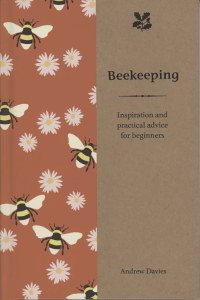 Beekeeping. Inspiration and practical advice for beginners.
Beekeeping. Inspiration and practical advice for beginners.
By Andrew Davies. Published by The National Trust Books, a registered UK Charity. Available at www.pavilionbooks.com. ISBN 978-1-90988-198-3½” x 7½”, 95 pgs, hard cover, black and white and color drawings. $12.95.
This is one of those little books you give to a friend who is thinking of taking up bees and doesn’t have a clue where to start. Yes, eventually a beginner’s class, an association and all the rest, but this is a good place to begin. Chapters include life in the hive, equipment needed, bee biology, inspections, managing bees, honey, problems (including Varroa), and the beekeeper’s year. The chapters are short but to the point, in an easy to read format, with good art, though not photos, to support the information. Got a friend who is thinking of bees? Give them a head start this Winter with this fine little book. – Kim Flottum
Visit www.pavilionbooks.com
 VENOM. The secrets of nature’s deadliest weapon.
VENOM. The secrets of nature’s deadliest weapon.
By Ronald Jenner and Eivind Undheim. Published by Smithsonian books, www.smithsonianbooks.com. ISBN 978-1-58834-454-0. 6¾” X 9”. 208 Pgs. Color throughout, soft cover. $19.95.
VENOM will bring you face to face with some of the most dangerous creatures on the planet, including jellyfish, snakes, and wasps. It explores the difference between venom and poison and how each is used for predation, defense, competition and even communication. Fossil records and DNA traces venom back to its origin. And finally, it examines the relationships between these dangerous creatures and humans. And even using them to create new drugs, treatments, and vaccines. This is a definitive guide to this most deadly way of life. And it is, even with these excellent explanations, still the scariest book I’ve read. The very last chapter is on honey bee venom and how it works, and how people have made it work for us. Compared to some animals, honey bees pale in comparison. Be very glad. – Kim Flottum
Visit www.smithsonianbooks.com
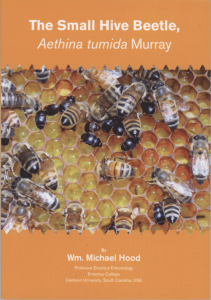 The Small Hive Beetle, Aethina tumida Murray.
The Small Hive Beetle, Aethina tumida Murray.
By Wm. Michael Hood, Prof. Emeritus, Clemson U. Published by Northern Bee Books, www.northernbeebooks.co.uk. ISBN 978-1-912271-07-8. 6½” X 9½”, 139 Pgs, color throughout, soft cover. $15.75.
The basics on this bee hive pest. Mike Hood did much of the ground work on this pest before he retired from Clemson, and has updated much of the information he presented in the first edition. Biology, history, importance, and most importantly (and easily 90% of the book, control. This includes preventing, cultural practices, monitoring, genetic control, mechanical control, physical control, biological control and finally chemical controls. He finishes with the Top 20 Small Hive Beetle Management Recommendations. For some this is a pest to deal with on and ongoing basis, and this is the book for you. Check it out. – Kim Flottum
Visit www.northernbeebooks.co.uk
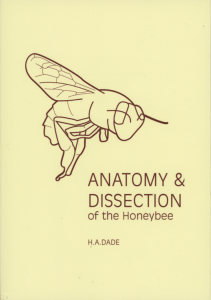 Anatomy & Dissection of the honey bee.
Anatomy & Dissection of the honey bee.
H. A. Dade. Published by Northern Bee Books and The International Bee Research Association. ISBN 978-0-86098-280-7. 196 pgs., black and white line drawings. Soft cover. Available at bookstores and Amazon, for $37.
This reprint of the original 1962 classic is still the basis of teaching beekeepers the structure of the honey bee in part 1, and how to dissect one to expose all the components of this amazing insect in part 2. The drawings are accurate and supurb and easy to use. Additions include the changes in technology in microscopes up to a point, and techniques in dissecting soft tissues. But if dissection is part of what you want to be doing, this is a good reference, and it includes hundreds of other references for you to check. – Kim Flottum
Visit www.amazon.com/Anatomy-Dissection-Honeybee-H-Dade
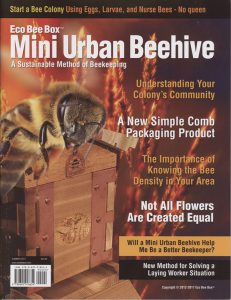 Mini Urban Beehive. A Sustainable Method of beekeeping.
Mini Urban Beehive. A Sustainable Method of beekeeping.
Albert Chubak. Published by EcoBeeBox. www.ecobeebox.com. ISBN 978-0-692-91865-4. 8½” X 11”, 40 pgs., color throughout. $24.95.
This isn’t a typical book. It’s more of an occasional magazine in format, but it has book-like information, and, magazine like articles, and, no advertising. It defies description. There will be more in this series, and they will be similar in size, content and scope, but they will cost much less. If you like the first one, and you will, the rest are easy to get, see below, and should probably be in you collection. Nevertheless, it has a focus and a good discussion on a lot of beekeeping application. The author lets the science to the scientists, and shares from that what it takes to do well with bees. It starts with lots of history of bee hives, and small hives in particular. This hive, named the Mini Urban Beehive, or MUB, is the focus here, after the history and other information. It has information on setting up one of these smaller hives, and using any one of nine techniques to do so, ranging from swarms, packages, splits, joining colonies and more. There are notes from users on how they coped with these hives and bees, what to look for when inspecting a MUB, different configurations of the four-box hive, contacts in every state, good neighbor beekeeping, types of bees, forage, propolis, using the observation windows to best advantage, feeding, using the foundationless frames, the Eco Bee Box Bracket, which holds everything together, wintering – this list goes on and on. Each topic briefly explained in the context of using these small hives. It has a useful glossary at the end. – Kim Flottum
You can find out more about these hives, and this book at
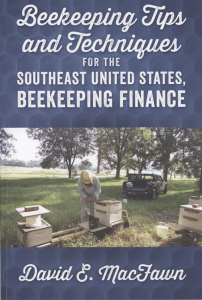 Beekeeping Tips and Techniques for the Southeast United States, and, Beekeeping Finance.
Beekeeping Tips and Techniques for the Southeast United States, and, Beekeeping Finance.
David MacFawn. Published by Outskirtspress, Inc. www.outskirtspress.com/bookstore. ISBN 978-1-478-79057-0. 6” x 9”, 145 pgs., color throughout, soft cover. $24.95.
Covering a topic seldom covered, beekeeping in the south, and the southeast to boot, this new release touches on a wide variety of topics, both fundamental and very advanced, most of us that live above the Mason/Dixon line either don’t know about, or don’t care about. And it’s about time. It tends to be a bit random, but at the end, you’ve covered everything you wanted covered. It’s a lot like having a beer with a beekeeper you just met and he’s sharing what he know, kind of like it just came to mind. However, the season guide brings it all together. And it adds a level almost nobody deals with, and that’s the finance side of running a bee operation, even though it is a bit SE centric. Basically, honey bee management must support honey bee biology, and then weighed for financial efficiency. Things you don’t at first think of – like how much does it cost to build a honey house? Competition with foreign beekeepers is small margin business, and every penny counts. Are farm markets worth the time? And, decisions that cost money, rather than make money count. There is a lot of spread sheet analyses of entire beekeeping operations to learn from, and better, to use, to make good biology, and good financial decisions. Beekeepers mostly don’t do this, and mostly, they should. Try it. – Kim Flottum









